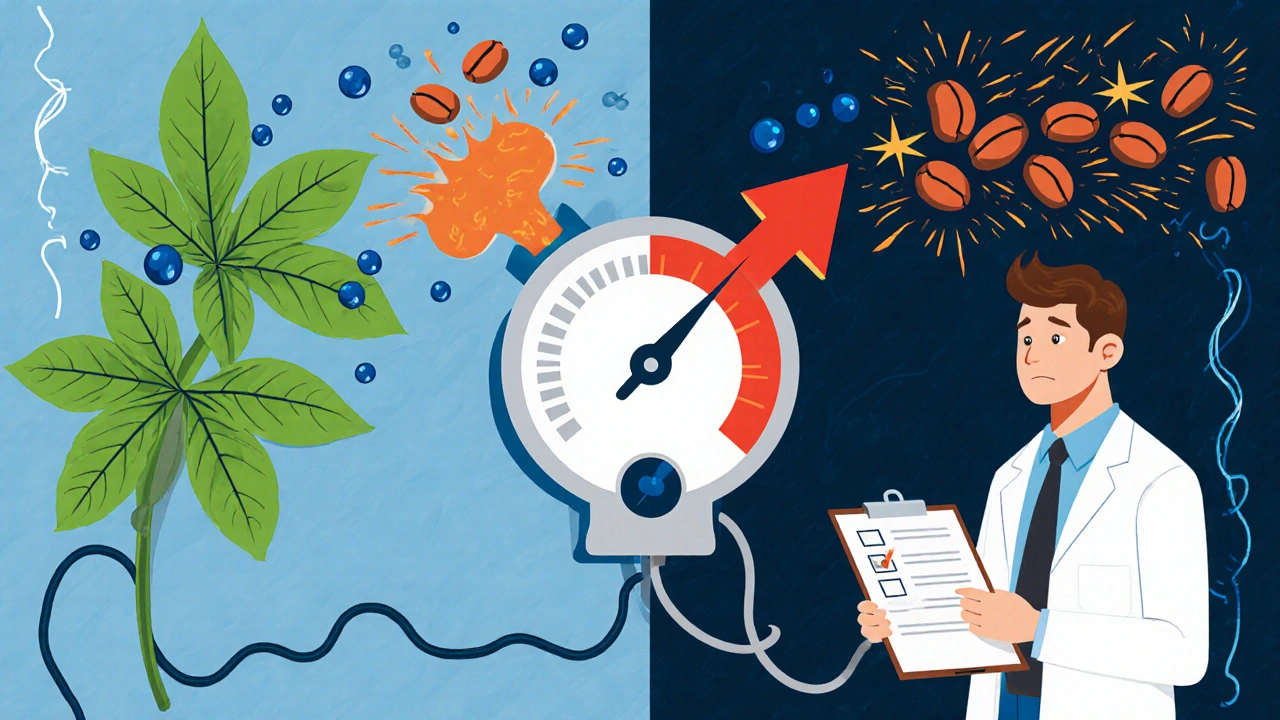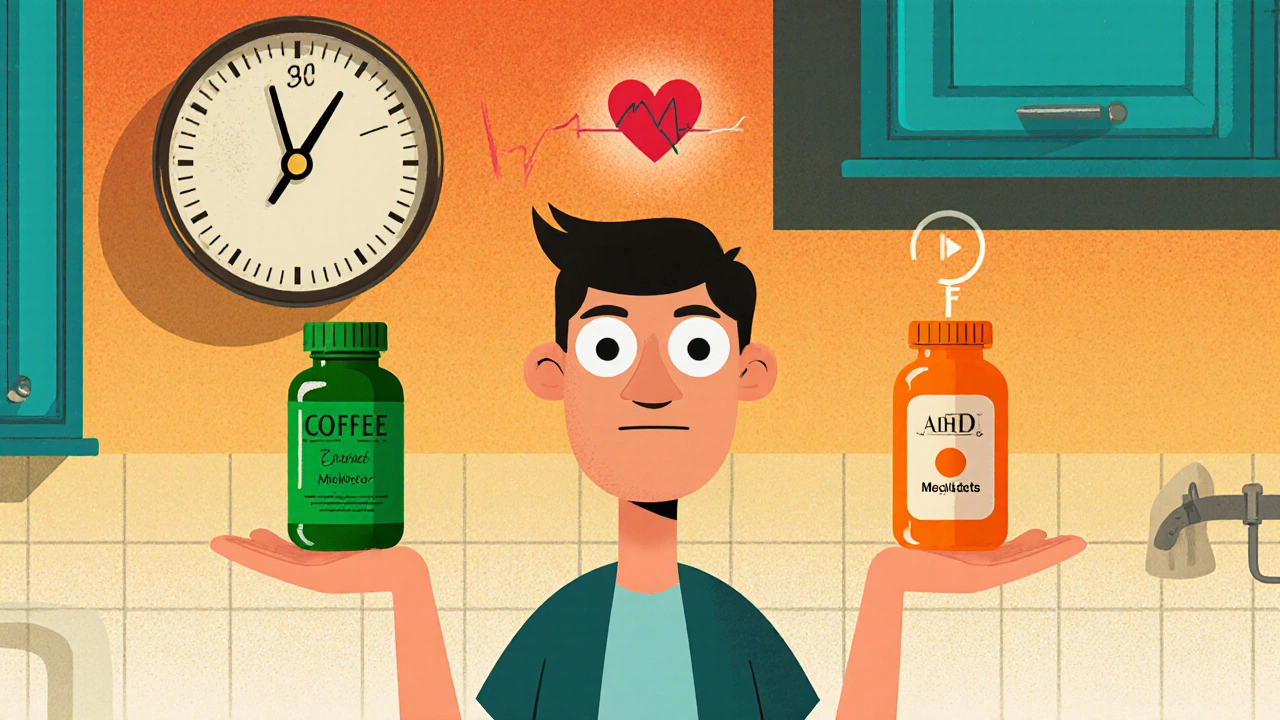Caffeine Calculator for Stimulant Users
Caffeine Calculator for Stimulant Users
Calculate your total daily caffeine intake from stimulant medications and green coffee extract to stay within safe limits for blood pressure management
Imagine juggling a weight‑loss supplement while your ADHD medication is already nudging your heart rate upward. That’s the real dilemma many patients face when green coffee extract meets stimulant drugs. Below we break down the science, the warning signs, and what you can do to keep your blood pressure steady.
Quick Takeaways
- Green coffee extract (GCE) contains chlorogenic acids that can lower blood pressure, but also caffeine that may raise it.
- Stimulant meds such as methylphenidate and amphetamines consistently increase systolic and diastolic pressures.
- Combining GCE with stimulants creates opposing forces that can cause erratic readings, dizziness, or even hypertension spikes.
- Healthcare providers should screen for GCE use, calculate total daily caffeine, and monitor BP twice daily for two weeks after any change.
- If you have pre‑existing hypertension, avoid GCE while on stimulant therapy unless a doctor explicitly approves.
What Is Green Coffee Extract?
Green Coffee Extract is a dietary supplement made from unroasted coffee beans (Coffea arabica) that delivers chlorogenic acids and varying amounts of caffeine. The extract hit the market after a 2009 Nestlé patent for a decaffeinated version, but most commercial products today still hold 5‑20 % caffeine alongside 45‑50 % chlorogenic acids.
Key actions:
- Chlorogenic acids (CGA) inhibit angiotensin‑converting enzyme (ACE), acting like a mild ACE‑inhibitor.
- CGA also modulates the 11β‑hydroxysteroid dehydrogenase type 1 (11β‑HSD1) enzyme, which can blunt cortisol‑driven blood‑pressure rises.
- Caffeine, an adenosine‑receptor antagonist, typically raises heart rate and systolic pressure.
Randomized trials (e.g., Hypertension Research 2006) showed that 93 mg and 185 mg doses of GCE cut systolic BP by roughly 5 mmHg on average, confirming the net depressor effect despite caffeine’s presence.
Stimulant Medications and Their Blood‑Pressure Profile
Stimulants prescribed for ADHD-most notably Methylphenidate (Ritalin, Concerta) and Amphetamines (Adderall, Vyvanse)-activate central norepinephrine and dopamine pathways. The FDA’s 2023 label updates list typical blood‑pressure increases of 2‑13 mmHg systolic and 1‑9 mmHg diastolic, depending on dose.
Mechanistically, stimulants cause peripheral vasoconstriction and increase cardiac output, which translates directly into higher arterial pressure. The American Heart Association’s 2022 statement recommends baseline and regular BP checks for every patient on these drugs.

When Two Opposites Meet: Interaction Risks
There’s no head‑to‑head trial that pits GCE against methylphenidate or amphetamines, but the pharmacology tells a clear story: one agent pushes pressure up, the other pulls it down. The clash can lead to:
- Unpredictable day‑to‑day BP swings-sometimes normal, sometimes hypertensive.
- Masking of side‑effects, making it harder for clinicians to gauge stimulant dose adequacy.
- Excess caffeine load: EFSA (2021) warns that total daily caffeine above 200 mg raises cardiovascular risk, and many GCE products already contribute 50‑200 mg per serving.
Real‑world evidence backs this up. A 2021 case report described a 34‑year‑old man on Adderall XR 30 mg whose systolic pressure bounced between 118 and 156 mmHg after adding a GCE supplement with 180 mg caffeine equivalents. ConsumerLab’s 2023 safety review logged 17 BP‑related adverse events linked to GCE, 9 of which involved concurrent stimulant use.
Key Factors That Influence the Interaction
Understanding why the same person may experience stable BP in one scenario but wild swings in another hinges on three variables:
- GCE composition: Chlorogenic‑acid content ranges from 28.7 % to 51.3 %; caffeine varies from 3.2 % to 18.7 % across brands. Higher caffeine means a stronger pressor push.
- Stimulant dose & timing: A 10 mg methylphenidate tablet taken in the morning will spike BP differently than a 60 mg extended‑release amphetamine taken twice daily.
- Individual cardiovascular baseline: Patients with pre‑existing hypertension, obesity, or high stress levels are more sensitive to both ACE inhibition and catecholamine surges.
Practical Guidance for Patients
If you’re on a stimulant and considering GCE, follow these steps:
- Ask your prescriber or pharmacist about any supplement you plan to add. The American Pharmacists Association (2023) advises specific screening for GCE when dispensing stimulants.
- Calculate total caffeine: Add the stimulant’s caffeine‑equivalent (roughly 5‑10 mg per 10 mg methylphenidate) to the GCE label’s amount.
- Stay below the 300 mg daily caffeine threshold for most adults; if you exceed it, discuss dose reduction or discontinuation.
- Monitor blood pressure twice daily (morning & evening) for at least two weeks after any change. Aim for < 140/90 mmHg and <10 mmHg systolic variation day‑to‑day.
- Watch for symptoms: sudden headache, dizziness, palpitations, or visual changes should prompt an immediate check‑in with your clinician.

Clinical Checklist for Healthcare Providers
Doctors, nurses, and pharmacists can use the following quick checklist when a patient mentions GCE while on stimulants:
| Step | Action |
|---|---|
| 1 | Ask explicitly about any herbal or weight‑loss supplement, including green coffee extract. |
| 2 | Document brand, dosage, and caffeine content from the label. |
| 3 | Calculate total daily caffeine (stimulant‑derived + supplement). |
| 4 | Review patient’s baseline BP and cardiovascular risk factors. |
| 5 | Advise a two‑week monitoring plan with morning/evening readings. |
| 6 | If BP exceeds 140/90 mmHg or varies >10 mmHg systolic, consider tapering/discontinuing GCE. |
| 7 | Educate patient on signs of hypertension escalation and when to seek urgent care. |
These steps reflect guidance from the European Society of Cardiology (2023) and the American Heart Association (2024) that stress proactive monitoring.
What the Future Holds
Research is catching up. A multicenter trial (NCT05678901) launched in early 2024 is enrolling 300 participants to directly compare methylphenidate with standardized GCE. Results are expected in mid‑2026 and should clarify dosing thresholds, safety margins, and whether the ACE‑inhibitory effect of chlorogenic acids can be harnessed therapeutically.
Meanwhile, regulatory agencies are tightening language. The European Medicines Agency added a specific warning about “potential hemodynamic instability when green coffee extract is combined with prescription stimulants” in its 2024 herbal medicines database. The FDA’s 2023 draft guidance on supplement‑drug interactions now lists GCE under “high‑risk” for patients on ADHD stimulants.
Bottom Line
Green coffee extract can lower blood pressure through chlorogenic acids, but its caffeine content and the sheer variability between brands make it a double‑edged sword for anyone on stimulant medication. The safest route is transparency with your healthcare team, diligent caffeine counting, and short‑term BP monitoring. Until robust trial data arrives, err on the side of caution-especially if you already have hypertension or a heart condition.
Can I take green coffee extract with my ADHD medication?
Most clinicians advise against it unless you have a clear monitoring plan. The combined caffeine load can exceed safe limits and cause unpredictable blood‑pressure swings.
How much caffeine is considered safe when mixing these substances?
For most adults, staying under 300 mg of total caffeine per day minimizes cardiovascular risk. Add the caffeine equivalents of your stimulant (roughly 5‑10 mg per 10 mg methylphenidate) to the amount listed on the green coffee extract label.
What symptoms should make me stop the supplement immediately?
Sudden headache, palpitations, dizziness, or a reading above 140/90 mmHg that persists for several hours are red flags. Contact your doctor or seek urgent care if these occur.
Are there any green coffee extract brands that are safer for stimulant users?
Look for products that disclose both chlorogenic‑acid percentage and exact caffeine milligrams per serving. Low‑caffeine, high‑CGA formulations (e.g., Naturex Green Coffee with 5 mg caffeine per capsule) are less likely to push you over the safe threshold.
Should I inform my pharmacist about taking green coffee extract?
Absolutely. The American Pharmacists Association recommends that pharmacists screen for green coffee extract when dispensing stimulant medications, because the combined caffeine load can be a hidden risk.

Alisha Cervone
October 26, 2025 AT 16:56Seems like another hype piece about supplements.
Diana Jones
November 18, 2025 AT 20:30Oh sure, because juggling chlorogenic acids and catecholaminergic spikes is exactly what my morning coffee routine needed. The way you break down ACE inhibition vs. adenosine antagonism is pure gold, if you ignore the fact that most patients can’t even count their caffeine. Remember, “total daily caffeine” isn’t just a buzzword – it’s a pharmacokinetic ceiling you should monitor like a lab. I love how you prompt us to calculate milligrams per pill – truly a motivational sprint for the ADHD community. If anyone doubts the risk, just look at the case reports and let the data do the heavy lifting. Keep the practical steps coming; they’re the real MVPs of this discussion.
Samantha Taylor
December 12, 2025 AT 00:03Thank you for the exhaustive overview, though I must point out that the literature you cite still leaves a substantial gap in mechanistic clarity. While you applaud the ACE‑inhibitory potential of chlorogenic acids, you conveniently neglect the fact that their bioavailability varies dramatically between extracts. Moreover, the cited Hypertension Research trial employed a narrow dosage window that does not reflect real‑world supplement usage. The interaction with stimulant‑induced catecholamine release remains speculative at best, given the paucity of head‑to‑head trials. Your recommendation to monitor blood pressure twice daily assumes patient compliance that is rarely observed outside of clinical trials. Nonetheless, the cautionary stance is commendable, if somewhat paternalistic. Future investigations should focus on standardized GCE preparations to reduce inter‑batch variability. Until then, clinicians must balance theoretical benefits against pragmatic risks.